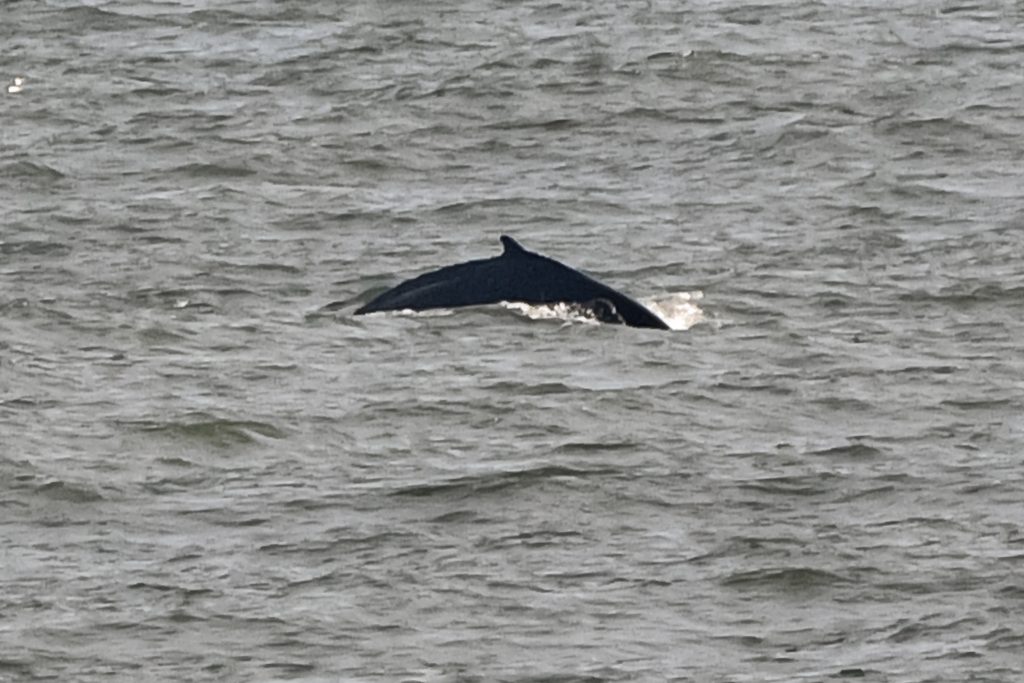We have had a chat with Martin Kitching, Sea Watch Regional Coordinator for NE England, about the most recent humpback whale sighted in the region.
Humpback whale Megaptera novaeangliae is a scarce species in north east England, with 15 records since 2006. Those 15 records are skewed towards August/September (9 records), with January/February accounting for most other sightings (4 records) and May having the remaining two. There’s been a noticeable increase in sightings recently with 5 records in 2019 and 2 in 2020. Although they’re perfectly happy in our shallower inshore waters, and can find abundant food sources, and not inspiring the same worry that comes with nearshore sightings of sperm whale Physeter macrocephalus, the spectre of entanglement in fishing gear raises its head whenever they’re sighted close to our coastline.

Mid-September 2019 saw a humpback whale with a section of its lower jaw missing, and some indication of previous entanglement injuries, swimming in the Tyne approaches. The same animal was seen, and photographed, breaching off the coast of East Yorkshire the following day, then a day after that sighting a dead whale was observed drifting off the coast of North Tyneside. That whale became entangled in a lobster pot line and was cut free, eventually beaching near Dunstanburgh Castle, and photographs taken off Whitley Bay while it was entangled showed that it wasn’t the injured whale from the Tyne approaches. I know the devastation that our commercial fishermen feel when cetaceans are lost to entanglement, but thankfully it still isn’t a major issue off the north east coast.
With national lockdown restrictions in force, the number of observers able to check the sea during their permitted daily exercise is currently very limited. I was out for my regular weekend walk on Sunday 31st January, and twice, in quick succession, failed to get my ‘phone out of my pocket before it went to voicemail (thick gloves and two coats…).
“I checked the missed calls, and when I saw that one was from a North East Cetacean Project volunteer, who lives on the coast, and the other was from Teri Charlton, one of the admin team on the NECP Facebook group, I realised there was something special happening“
A quick check of my messenger inbox unveiled several excited messages and, initially, one photograph of a whale that looked to be potentially a sperm whale! I spoke to the coastguard to give them a heads-up, and to reassure them that we would sit on the location as far as possible, because people visiting the coast without justification has been an issue through all of the movement restrictions during the last 10 months.
“As more photos, and observer reports, appeared it was clear that there were two humpback whales present!”
Once all of the initial excitement calmed (at least in my house, I know a couple of places where it didn’t…) I settled down to review nearly 400 images, eventually confirming that the initial image was a humpback whale blowhole and there were no images of sperm whale.




Photos credits: ©north east cetacean project
We withheld the location, and observer details, and shared a few images on the NECP FB group. One of our other volunteers, who is able to take their daily exercise on the coast, checked a long stretch of coast first thing on Monday 1st February and had just reported no sightings when the whales appeared in the same location as they had on Sunday! With lots of images, we’re working with Lyndsay McNeill and the Scottish Humpback ID project to see if we can identify these whales individually.
Our cetacean-watching community in the north east is a great network of observers along the length of our coastline and anything out of the ordinary always makes me incredibly grateful for all of our observers, the other organisations that we liaise with, particularly the coastguard and Northumberland IFCA who are on the coast so much of the time, and our commercial fishermen, jet ski users, divers, and all of the other interest groups who engage so well with each other in appreciation and care for our marine wildlife. Teri’s ability to function as a hyper-efficient and inclusive communication hub, as she did during the tragic episode of the Sandy Bay sperm whale in October 2019 , and when we organised a search for four sperm whales in late December 2019, really needs to be acknowledged too J Alongside Jo and Steve, who are the other NECP admins, we work to encourage engagement between NGO’s (as well as Northumberland/Durham coordinator for the Sea Watch Foundation, I am the NE regional officer for MARINElife), public authorities, research groups and anyone with an interest in the marine environment.
Martin Kitching
Sea Watch Regional Coordinator
Feature Blogger
























